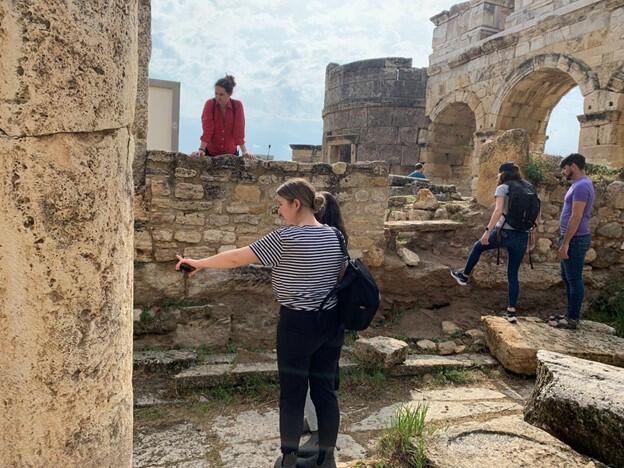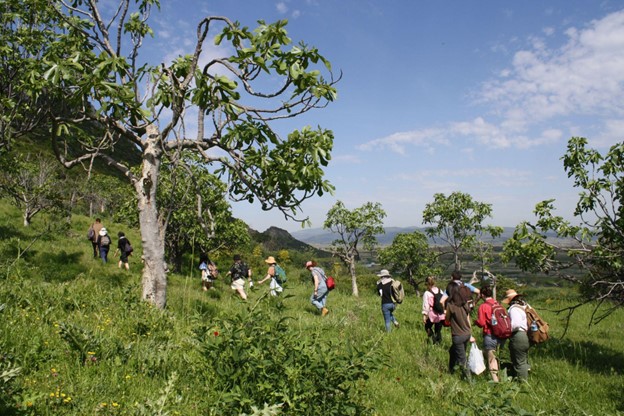
ARCHAIA Study-abroad tour to Greece and Turkey, spring 2023
(written by: Elizabeth Hane)
On April 29th, 2023, students in Buckingham Professor of New Testament Criticism and Interpretation Laura Nasrallah’s course “The Archaeology of the Roman Empire for the Study of the New Testament and Early Christianity” flew to Izmir for their more than two-week adventure across Greece and Turkey. Joined by now-Vassar Assistant Professor of Greek and Roman Studies CJ Rice, Yale Religious Studies Ph.D. candidates Julia Nations-Quiroz and CJ Rice (now assistant professor of Greek and Roman studies at Vassar College), Stanford Teresa Hihn Moore Professor of Religious Studies Michael Penn, and (in Turkey) their fearless tour guide and local expert Gülin Pazaroglu, ten students trekked across urban cityscapes, hiked rocky hills to sacred spaces, and sketched objects in over fourteen different museums.
Beginning with Sardis, students learned about the synagogue and its complex presence in the Roman city. Students then learned about amuletic inscriptions in Miletos, walked amidst the towering columns of Didyma and its daemonic inscriptions, and discussed graffiti and economics with archaeologists at elite domestic structures in Ephesos. On the road to Pamukkale, students stopped at Aphrodisias, where they sat amidst the theatre and reflected on the competition between the Blue and the Green factions during the late antique period. Near Pamukkale’s thermal springs, students debated the economic competition between nearby cities of Laodikeia and Hieropolis in ancient literary sources. Thinking through the impacts of such a geographically active area, students utilized New Materialist thinking to consider nature and matter alongside infrastructure, ritual, and everyday life. Finally, in Istanbul, students were joined by former Archaia postdoc and now Bard Assistant Professor of Art History Anne Chen to learn from her expertise in imperial architecture, building use and reuse, and the challenges of excavation in a continually-inhabited city.
This academic pilgrimage concluded in Greece, where students stayed at Kavala, Thessaloniki, and Athens. Students learned about public latrines and ancient Christian architecture in Philippi. Before departing from the group, Professor Chen gave a final lecture on the imperial palaces of Thessalonikē and the Tetrarchs’ heated competition and collaboration with each other, as represented in the so-called Arch of Galerius. Once in Athens, students took day trips around the city and to nearby Corinth to learn about ancient burial practices and archaeological methods for excavating graves, considered the influence of Neoplatonic theurgy on early Christian ritual, and looked out from the top of the Acropolis on the bustling heart of Greece. After seventeen days abroad, and with newfound knowledge on the city layouts, structures, and landscapes of people in the ancient Eastern Mediterranean, students parted ways—some towards further archaeological research, others to well-deserved rest back home.
Just behind the theatre at Miletos, Laura Nasrallah, right, discusses the amuletic inscription with her students. These amuletic inscriptions feature heavily in her forthcoming book, Ancient Christians and the Power of Curses. Image courtesy of CJ Rice.

Claire Campbell (YDS MAR ‘24) and Alana Zimath (YDS MAR ‘24), departing from the theatre complex, cheerfully walk through the remains of Miletos,. Image courtesy of Lizzy Hane.

Over rock and under tree, students march through a fig grove towards the Grotto of Paul and Thecla at Ephesos. Image courtesy of CJ Rice.

Outside the Grotto of St. Paul and Thecla, students ready themselves to enter the tight space of the cave. Image courtesy of CJ Rice.

Alyssa Zimmer (YDS MAR ‘24) gazes upon the painting of Thecla’s mother and Paul in the Grotto of St. Paul and Thecla at Ephesos. Image courtesy of CJ Rice.

Bark-iologists at Ephesos, hard at work looking for inscriptions. Image courtesy of Lizzy Hane.

Lizzy Hane (MAR ‘24) looks upon an inscription of a Latin letter sent by emperors Valentian, Valens, and Gratianus to Festus, Governor of Ephesos. Image courtesy of Michelle Keefe.

Students gather around hot coals to warm themselves after getting caught in the rain at Aphrodisias. Front: Rachel Park (MAR ‘24) and Rachel Beaver (MAR ‘24). Back: Mikayla Bezzant (MAR ‘23). Claire Campbell (MAR ‘24), Alyssa Zimmer (MAR ‘24), CJ Rice, and Maria Chen (MAR ‘24). Image courtesy of Gülin Pazaroglu.

Excitement and anxiety brew as Alana Zimath (MAR ‘24) reads aloud prophecies for each student at Hierapolis, based upon divinatory inscriptions found on the site. While Prof. Michael Penn, left, and Gülin Pazaroglu, center, appear pleased with their results, Claire Campbell (MAR ‘24), right, awaits in curiosity. Image courtesy of Lizzy Hane.

Mikayla Bezzant (MAR ‘23) points out the architectural features of the latrines at Hierapolis to onlooking students Claire Campbell (MAR ‘24), seen above Mikayla, and Alana Zimath (MAR ‘24), who is behind Mikayla. Image courtesy of Lizzy Hane.

Mikayla Bezzant (MAR ‘23) and Lizzy Hane (MAR ‘24) take a selfie in Hagia Sophia in Istanbul! Though the company arrived early in the morning, the sacred site was nevertheless packed. Photo courtesy of Mikayla Bezzant.

Cat, seated upon a Theodosian capital, engages in paws-on archaeology. She attempts to discern the material’s warmth in front of the Archaeological Museum in Istanbul. Image courtesy of Lizzy Hane.

After a six-hour bus ride from Istanbul, CJ Rice, Julia Nations-Quiroz, Michelle Keefe, and Prof. Anne Chen braved the steps up towards the Acropolis at Kavala. Here they can be seen smiling after a successful hike at the end of a long day. Image courtesy of Rice.

All smiles and joy atop the Areopagus in Athens! From left to right: Prof. Laura Nasrallah, CJ Rice, Michelle Keefe (MAR ’23, now Ph.D. Medieval Studies, Yale University), Julia Nations-Quiroz, and Rachel Park (MAR ‘24). Image courtesy of Rachel Park.

Excited at the Acropolis Museum in Athens! Julia Nations-Quiroz and Michelle Keefe come face to face with the original caryatids. Image courtesy of Nations-Quiroz.
Archaia is grateful to the MacMillan Center for making this study tour possible.
